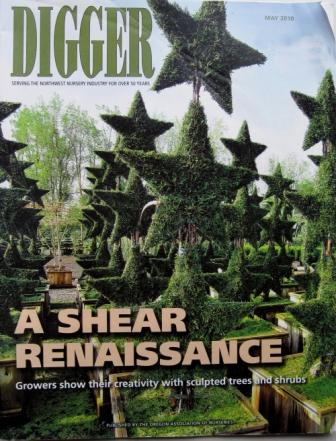
I subscribe to Digger magazine, the industry publication from Oregon Association of Nurserymen. I am always curious about trends in the nursery industry and this magazine is a good way to find out what home gardeners are buying.

The cover feature of the May 2010 issue is on topiary. While I can appreciate topiaries in formal gardens – with dozens of gardeners to keep them shaped up – I think they are poor choices for most home landscapes. Shearing plants to maintain a particular size or shape is a never-ending activity that most homeowners will tire of quickly. Nevertheless, the magazine reports that topiaries are becoming more popular for home landscapes, especially along the East Coast. The article showcases the newer topiary shapes – stars, crosses, angels, even cacti – in addition to the traditional spirals and poms.

The article warns growers that skilled employees are needed to prune topiaries properly, and that the time commitment to create and maintain topiaries is significant. One grower states “it’ll take a fair amount of time to shape it, and then you’ll be trimming it lightly a couple of times a year until you sell it.”

Curiously, the article says nothing about either the time commitment or pruning skills needed for homeowners who purchase topiaries.

Even more curious…the subsequent issue of Digger is devoted to sustainability. Seems a bit of a disconnect there.

I have rarely seen topiaries look good in a home landscape, too contrived. Although the 1st photo does look pretty good. I must say. I wonder if it would look as good if I were walking past it? Or maybe the flatness of the photo makes the geometry look good?
Oh, boy! Time commitment and pruning skills really are two giant considerations when anyone’s thinking of making or buying topiary. Simpler is so much easier to take care of! Winterburn or pathogens can zap chunks out of a carefully sculpted topiary, and keeping a carved plant looking as mannered as topiary should be takes tons of time. It makes me tired to think of maintaining a plant this way.
I like the first one too. Somewhere around here I have a picture of a house in KC, MO with wonderful topiary in the front yard. But then, it stands out because it’s so rare that homeowners can do it correctly. Those spiral junipers die a slow awful death right out there by the front door!
Bah, humbug. Pruned and sheared shrubs have been used in gardens extensively for centuries–a millennium at least, I’d say. And they’ve looked quite good in many different contexts. A topiary is an extreme end of shearing, but there are 300+ old yew that have been sheared and pruned for 300+ years that still look good.